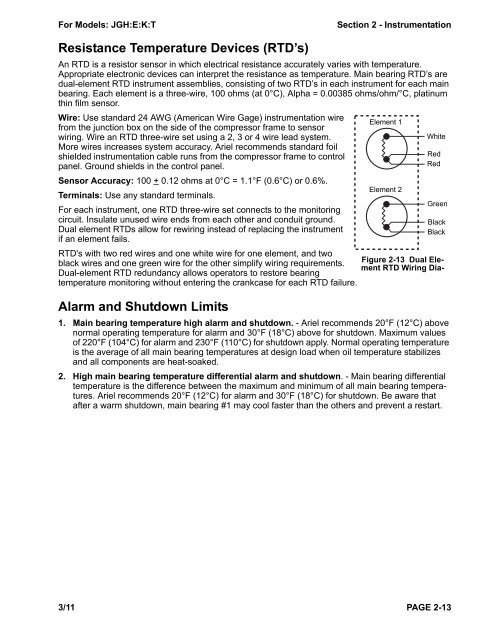Heavy Duty Balanced Opposed Compressors - Ariel Corporation
Heavy Duty Balanced Opposed Compressors - Ariel Corporation
Heavy Duty Balanced Opposed Compressors - Ariel Corporation
Create successful ePaper yourself
Turn your PDF publications into a flip-book with our unique Google optimized e-Paper software.
For Models: JGH:E:K:T Section 2 - Instrumentation<br />
Resistance Temperature Devices (RTD’s)<br />
An RTD is a resistor sensor in which electrical resistance accurately varies with temperature.<br />
Appropriate electronic devices can interpret the resistance as temperature. Main bearing RTD’s are<br />
dual-element RTD instrument assemblies, consisting of two RTD’s in each instrument for each main<br />
bearing. Each element is a three-wire, 100 ohms (at 0°C), Alpha = 0.00385 ohms/ohm/°C, platinum<br />
thin film sensor.<br />
Wire: Use standard 24 AWG (American Wire Gage) instrumentation wire<br />
from the junction box on the side of the compressor frame to sensor<br />
wiring. Wire an RTD three-wire set using a 2, 3 or 4 wire lead system.<br />
More wires increases system accuracy. <strong>Ariel</strong> recommends standard foil<br />
shielded instrumentation cable runs from the compressor frame to control<br />
panel. Ground shields in the control panel.<br />
Sensor Accuracy: 100 + 0.12 ohms at 0°C = 1.1°F (0.6°C) or 0.6%.<br />
Terminals: Use any standard terminals.<br />
For each instrument, one RTD three-wire set connects to the monitoring<br />
circuit. Insulate unused wire ends from each other and conduit ground.<br />
Dual element RTDs allow for rewiring instead of replacing the instrument<br />
if an element fails.<br />
RTD's with two red wires and one white wire for one element, and two<br />
black wires and one green wire for the other simplify wiring requirements.<br />
Dual-element RTD redundancy allows operators to restore bearing<br />
temperature monitoring without entering the crankcase for each RTD failure.<br />
Alarm and Shutdown Limits<br />
Element 1<br />
Element 2<br />
3/11 PAGE 2-13<br />
White<br />
Red<br />
Red<br />
Green<br />
Black<br />
Black<br />
Figure 2-13 Dual Element<br />
RTD Wiring Dia-<br />
1. Main bearing temperature high alarm and shutdown. - <strong>Ariel</strong> recommends 20°F (12°C) above<br />
normal operating temperature for alarm and 30°F (18°C) above for shutdown. Maximum values<br />
of 220°F (104°C) for alarm and 230°F (110°C) for shutdown apply. Normal operating temperature<br />
is the average of all main bearing temperatures at design load when oil temperature stabilizes<br />
and all components are heat-soaked.<br />
2. High main bearing temperature differential alarm and shutdown. - Main bearing differential<br />
temperature is the difference between the maximum and minimum of all main bearing temperatures.<br />
<strong>Ariel</strong> recommends 20°F (12°C) for alarm and 30°F (18°C) for shutdown. Be aware that<br />
after a warm shutdown, main bearing #1 may cool faster than the others and prevent a restart.















